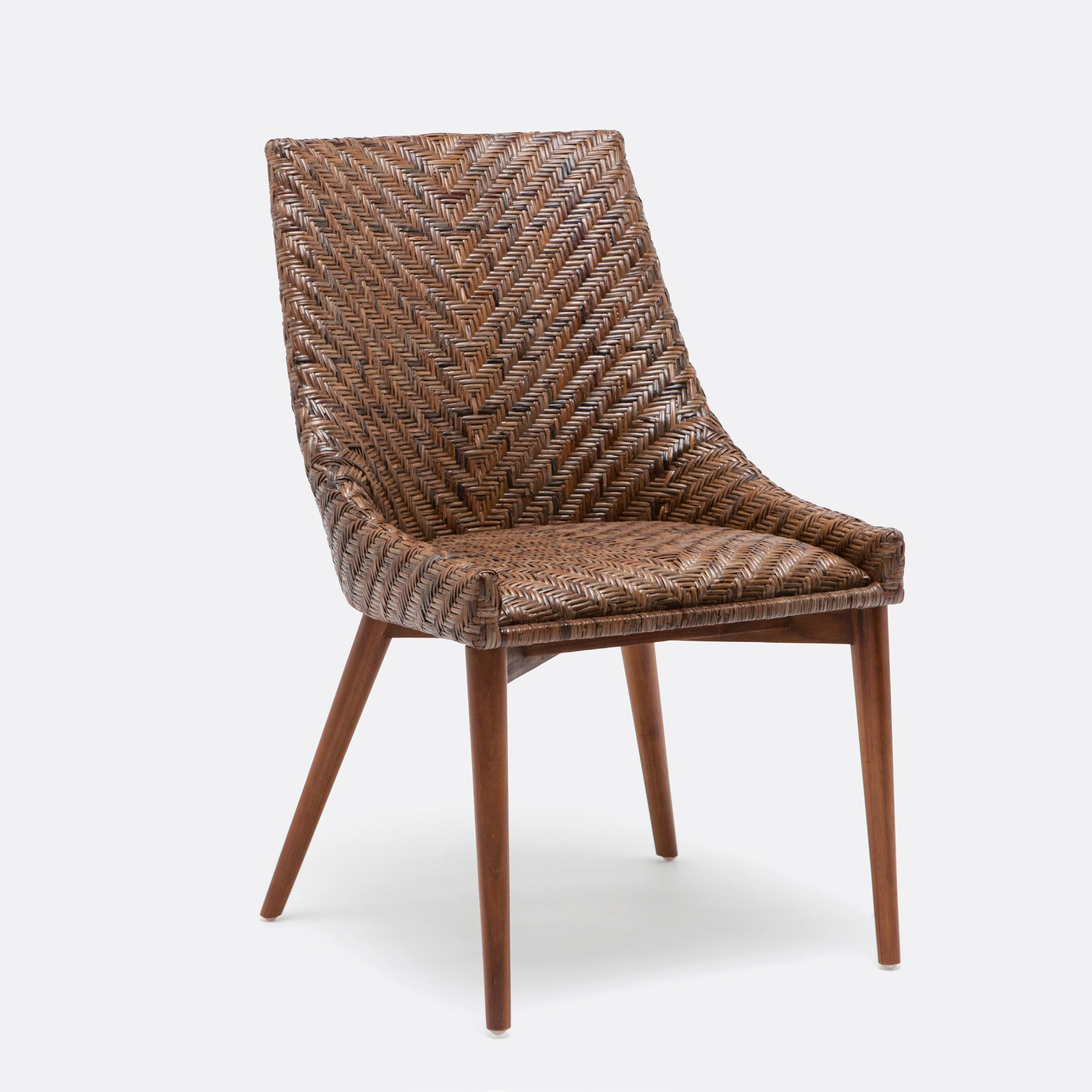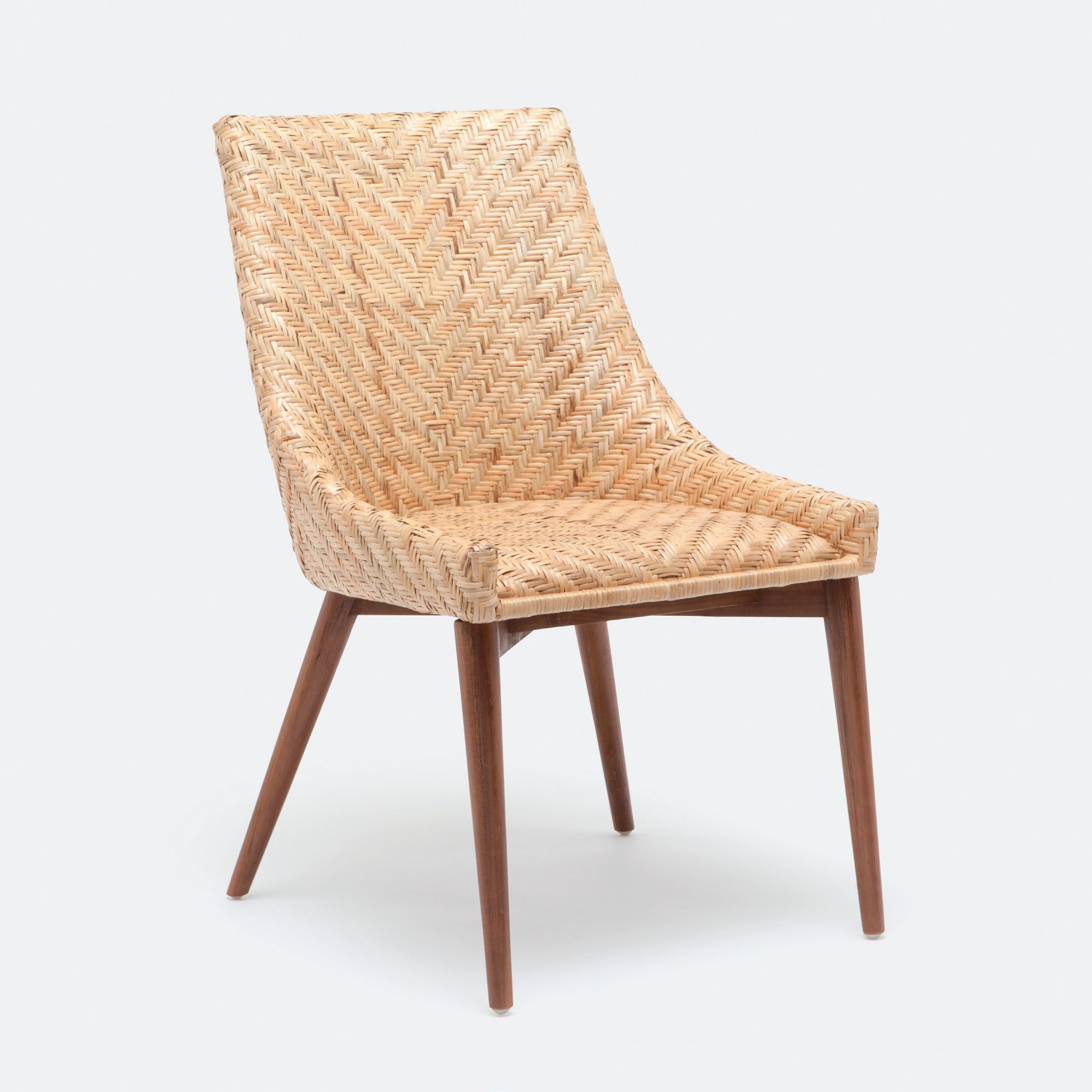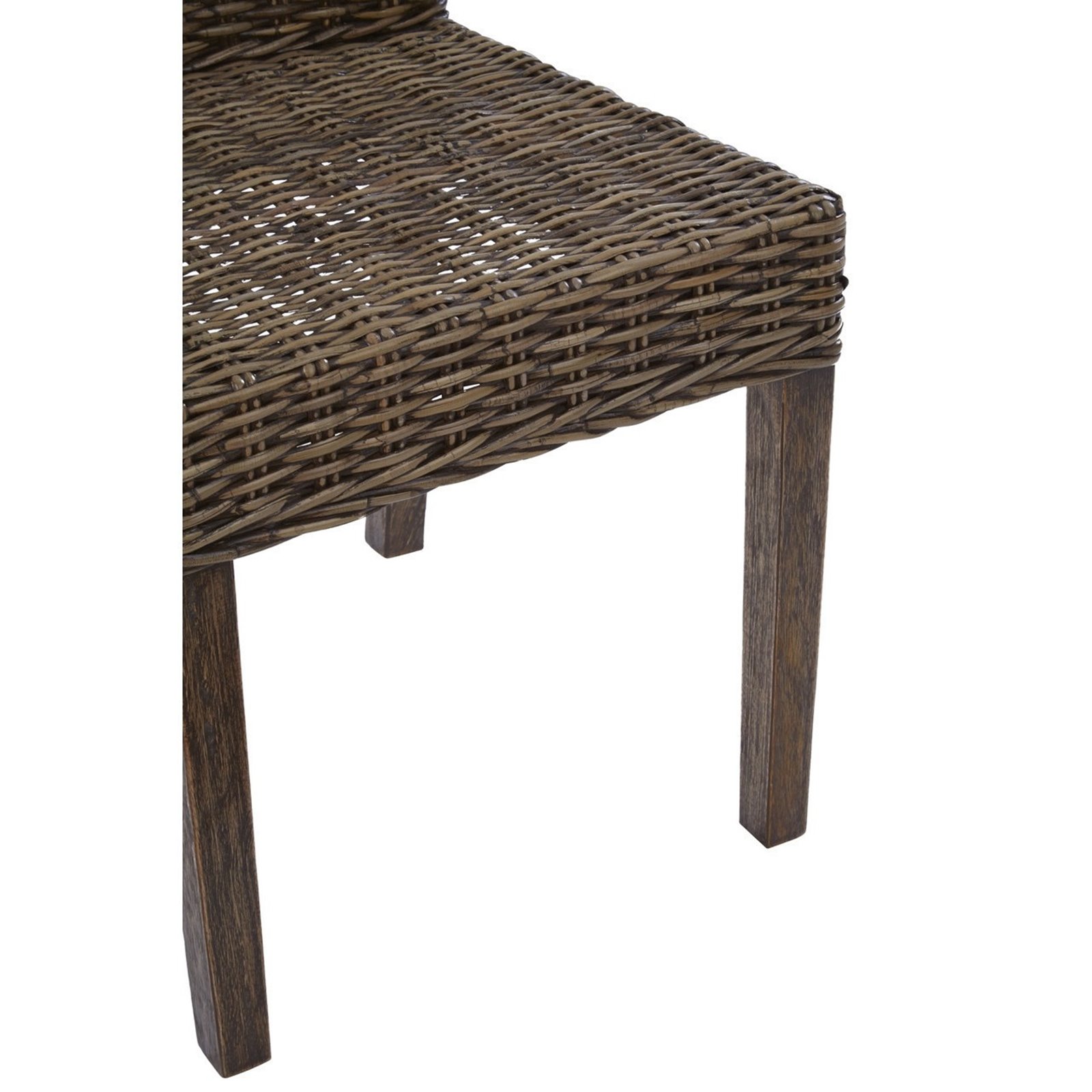Design & Aesthetics of Woven Rattan Dining Chairs

The inherent beauty of woven rattan lends itself beautifully to the creation of dining chairs, offering a unique blend of natural elegance and enduring style. From rustic charm to sleek modernism, rattan’s versatility allows for a wide range of aesthetic expressions, transforming any dining space. This exploration delves into the diverse design styles, visual appeal, and creative possibilities offered by woven rattan dining chairs.
Design Styles of Woven Rattan Dining Chairs
The artistry of rattan weaving allows for an impressive spectrum of design styles. Each style speaks to different tastes and design philosophies, seamlessly integrating into various interior aesthetics.
- Traditional: These chairs often feature robust frames and intricate, densely woven patterns. Think deep, rich browns, perhaps with hints of darker accents, evoking a sense of timeless craftsmanship and rustic charm. They often showcase classic silhouettes, such as the iconic Windsor chair style adapted for rattan. The overall effect is one of warmth and heritage.
- Modern: Modern rattan dining chairs often embrace clean lines and simpler weaving patterns. They might utilize lighter, more natural rattan tones, sometimes paired with contrasting metal accents (black or brushed gold) for a touch of sophistication. Shapes tend towards geometric forms and streamlined designs, reflecting contemporary aesthetics.
- Minimalist: Minimalist rattan chairs prioritize simplicity and functionality. The weaving is often sparse and open, showcasing the natural beauty of the material without excessive embellishment. Neutral colors dominate, allowing the chair to blend seamlessly into a minimalist interior scheme. The overall feel is clean, airy, and uncluttered.
Comparison of Woven Rattan with Other Dining Chair Materials
Rattan’s unique qualities distinguish it from other popular dining chair materials. This comparison highlights the advantages and disadvantages of each.
| Style | Material | Pros | Cons |
|---|---|---|---|
| Traditional | Wood | Durable, classic look, wide range of finishes | Can be heavy, susceptible to scratches and dents, higher price point for high-quality wood |
| Modern | Metal | Lightweight, easy to clean, sleek and contemporary | Can be cold to the touch, prone to rust or corrosion, potentially less comfortable for extended periods |
| Minimalist | Rattan | Lightweight, breathable, natural aesthetic, sustainable | Can be less durable than wood or metal, requires careful maintenance to prevent damage |
Detailed Description of a Hypothetical Woven Rattan Dining Chair
Imagine a dining chair crafted from a rich, honey-colored rattan. The seat and back are woven in a complex herringbone pattern, with subtly varying shades of brown creating depth and visual interest. The texture is surprisingly smooth against the skin, despite the intricate weaving. The chair’s legs are slender yet sturdy, tapering elegantly towards the floor, finished with dark, protective caps. The overall shape is slightly curved, offering both comfort and visual appeal, creating a chair that feels both modern and timeless.
Three Woven Rattan Dining Chair Concepts
Woven rattan dining chair – Concept 1: Formal Dining Chair. This chair features a tightly woven, almost tapestry-like back and seat, in a deep, dark brown rattan. The legs are elegantly curved, and the overall silhouette is stately and refined. This chair is ideal for a formal dining room, complementing classic or traditional decor and creating a sophisticated atmosphere. Its target audience is those who appreciate classic elegance and timeless design.
Concept 2: Casual Dining Chair. This chair embraces a lighter, more open weave, in a natural, light brown rattan. The design is simpler, with straight legs and a slightly more relaxed seat and back. It’s perfect for a casual dining space, adding a touch of natural warmth without overwhelming the room. The target audience is those seeking relaxed comfort and natural aesthetics in their everyday dining area.
Concept 3: Outdoor Dining Chair. This chair utilizes a weather-resistant, treated rattan in a light grey or whitewash finish. The weave is slightly looser to allow for better air circulation, and the frame is reinforced for added durability. It is designed for outdoor use, adding a touch of style to patios and gardens. Its target audience is those seeking durable and stylish seating for outdoor entertaining.
Manufacturing & Materials of Woven Rattan Dining Chairs

The transformation of raw rattan into a beautiful and functional dining chair is a testament to skilled craftsmanship and the enduring appeal of natural materials. From the careful selection of rattan poles to the final sanding and finishing, each step contributes to the chair’s unique character and longevity. This process, often passed down through generations, blends traditional techniques with modern efficiency.
- Sourcing and Preparation: The journey begins in the rattan-growing regions, where experienced harvesters select mature canes ensuring sustainable practices. These canes are then carefully transported, often with minimal processing to preserve their integrity. Once at the workshop, they are sorted by diameter and quality, and then meticulously cleaned and soaked to increase flexibility and reduce brittleness.
- Weaving and Shaping: Skilled artisans, often working with traditional tools, begin the intricate process of weaving. This involves bending, shaping, and interlacing the rattan canes to create the chair’s back, seat, and legs. The weaving patterns can vary widely, reflecting regional styles and the artisan’s skill. The frames, often made of stronger, more durable wood, provide structural support to the woven rattan.
- Finishing and Quality Control: Once the weaving is complete, the chair undergoes a rigorous quality check. Any imperfections are addressed, and the chair is then sanded smooth. Finally, it receives a protective finish, often a natural oil or varnish, to enhance its durability and water resistance, bringing out the natural beauty of the rattan.
Types of Rattan Used in Furniture Making
The choice of rattan significantly impacts the chair’s final properties. Different types offer varying degrees of strength, flexibility, and durability. Understanding these differences is crucial for selecting the appropriate material for dining chairs, which require a balance of strength and aesthetic appeal.
- Manau Rattan: Known for its strength and durability, Manau rattan is a popular choice for chair frames and structural elements. Its thicker, more robust nature makes it ideal for supporting weight and resisting wear and tear.
- Seagrass: While not technically rattan, seagrass is often used in conjunction with rattan for weaving chair seats and backs. It offers a lighter, more flexible option, often contributing to the chair’s aesthetic appeal.
- Dragon Rattan: This type boasts excellent flexibility and is often used for intricate weaving patterns. However, it might be less durable than Manau rattan for high-stress areas.
Environmental Impact of Rattan Harvesting and Manufacturing
Sustainable harvesting practices are paramount to minimizing the environmental impact of rattan furniture production. Unsustainable harvesting can lead to deforestation and habitat loss. The manufacturing process itself can also contribute to pollution if not managed responsibly.
Responsible harvesting involves selective cutting, ensuring that enough canes are left to allow for regeneration. Furthermore, the use of natural, non-toxic finishes minimizes pollution during the manufacturing process. Supporting companies committed to sustainable sourcing and ethical labor practices is crucial for ensuring the long-term viability of the rattan furniture industry. Certification schemes, such as the Forest Stewardship Council (FSC), can help consumers identify sustainably sourced products.
Cost Breakdown of Manufacturing a Woven Rattan Dining Chair
The cost of manufacturing a woven rattan dining chair varies depending on several factors, including material quality, labor costs, and overhead expenses. The following table provides a sample cost breakdown, based on a mid-range chair produced in a small workshop. Note that these figures are estimates and can vary significantly depending on location and specific circumstances.
| Cost Item | Quantity | Unit Cost | Total Cost |
|---|---|---|---|
| Rattan Poles (various types) | 5 kg | $10/kg | $50 |
| Wood for Frame | 1 m | $20/m | $20 |
| Finishing Materials (oil, varnish) | 1 liter | $15/liter | $15 |
| Labor (weaving, finishing) | 8 hours | $20/hour | $160 |
| Overhead (rent, utilities) | – | – | $50 |
| Total Cost | – | – | $295 |
Care & Maintenance of Woven Rattan Dining Chairs

Your woven rattan dining chairs, with their inherent charm and natural beauty, deserve proper care to ensure they remain a cherished part of your home for years to come. Understanding the nuances of rattan maintenance will help preserve their elegance and extend their lifespan significantly. This section will provide practical guidance on cleaning, storage, protective treatments, and minor repairs.
Cleaning and Maintaining Woven Rattan Dining Chairs
Regular cleaning is key to preventing dirt and grime from accumulating and potentially damaging the rattan. A consistent approach will keep your chairs looking their best and protect them from deterioration. The following steps offer a practical guide to maintaining the pristine condition of your rattan furniture.
- For routine cleaning, use a soft-bristled brush or a vacuum cleaner with a brush attachment to remove loose dust and debris. Gentle strokes will prevent damage to the delicate rattan weave.
- For more stubborn dirt, mix a mild solution of warm water and gentle dish soap. Dip a soft cloth into the solution, wring it out thoroughly to avoid excess moisture, and gently wipe down the rattan. Always test any cleaning solution on an inconspicuous area first.
- To remove stains, act quickly. Blot (don’t rub!) spills immediately with a clean cloth. For tougher stains, a solution of mild soap and water may suffice; for more persistent marks, consider a specialized rattan cleaner available from furniture stores. Remember to always test any cleaning solution on a hidden area first.
- After cleaning, allow the chairs to air dry completely in a well-ventilated area, away from direct sunlight or heat. Avoid using harsh chemicals, abrasive cleaners, or excessive moisture, as these can damage the rattan.
Proper Storage of Woven Rattan Dining Chairs
Storing your rattan chairs correctly, especially during periods of extreme temperature or humidity fluctuations, is vital for preserving their integrity. Exposure to harsh weather conditions can cause the rattan to dry out, crack, or become brittle. Proper storage minimizes these risks.
Proper storage safeguards your rattan chairs from the damaging effects of extreme temperatures and humidity. During periods of extreme heat, direct sunlight can cause the rattan to dry out and become brittle. Conversely, excessive humidity can lead to mold and mildew growth. Therefore, storing the chairs in a cool, dry, and well-ventilated area is crucial. Ideally, a climate-controlled environment is best; however, a covered porch or garage provides adequate protection in moderate climates. To further protect the chairs from dust and moisture, consider covering them with breathable fabric covers.
Protective Treatments for Woven Rattan
Several protective treatments can enhance the durability and longevity of your rattan chairs. Each offers unique benefits and drawbacks, making the choice dependent on your specific needs and preferences.
- Rattan Sealant: This provides a protective barrier against moisture and UV damage, maintaining the rattan’s natural color and preventing cracking. However, it can alter the rattan’s natural texture slightly.
- Natural Oils: Linseed oil or tung oil can nourish the rattan, adding moisture and enhancing its flexibility. This method is eco-friendly but requires more frequent reapplication.
- UV-Resistant Spray: This protects against fading caused by sun exposure, preserving the rattan’s color for longer. It’s easy to apply but might not offer as much protection against moisture.
Repairing Minor Damage to Woven Rattan Chairs
Minor damage, such as loose weaves or small cracks, can often be repaired at home. Early intervention prevents the damage from worsening and extending the life of your chairs.
- Loose Weaves: Imagine a close-up of a frayed rattan strand; use a needle and strong, flexible thread (preferably in a color that matches the rattan) to carefully re-weave it into place. Work slowly and methodically, ensuring the new weave is secure and blends seamlessly with the existing structure.
- Minor Cracks: For small cracks, carefully apply a thin layer of wood glue to the affected area. Gently clamp the crack closed using small clamps, ensuring even pressure. Allow the glue to dry completely according to the manufacturer’s instructions. Once dry, lightly sand the area smooth, ensuring a seamless finish.
